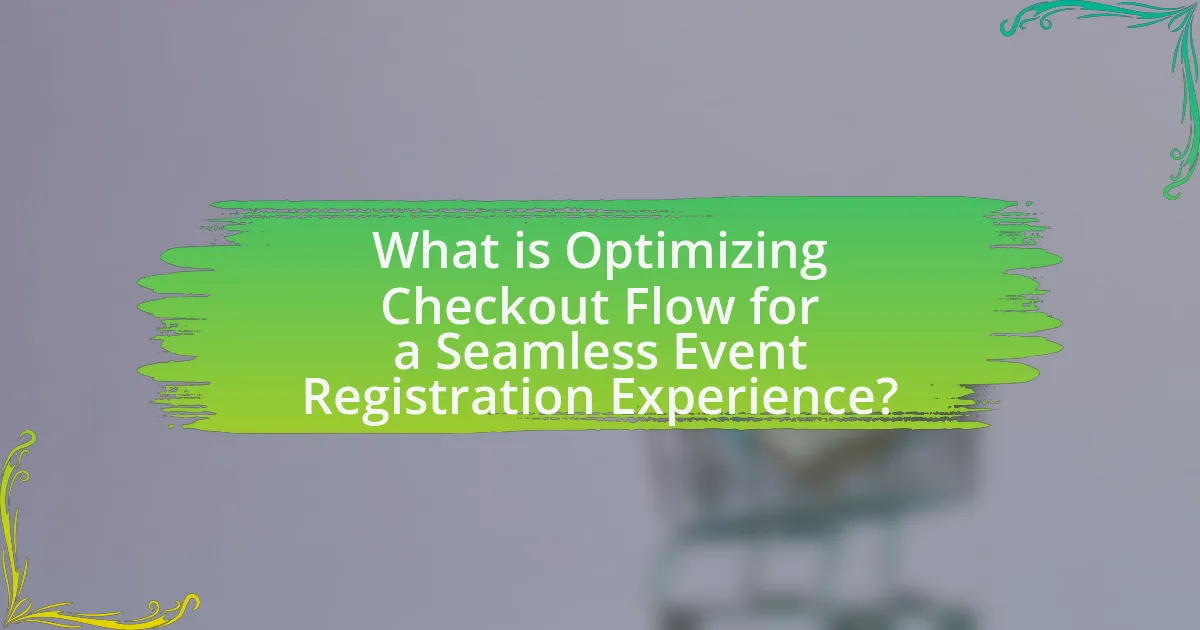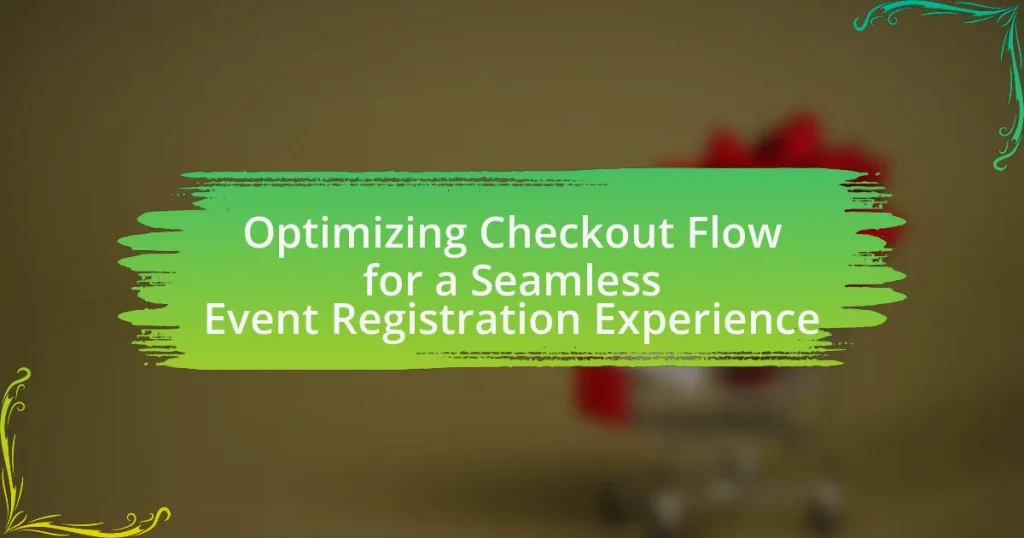Optimizing checkout flow for a seamless event registration experience is essential for enhancing user satisfaction and increasing conversion rates. The article examines the impact of checkout flow on event registration, highlighting the importance of minimizing steps, offering guest checkout options, and ensuring mobile compatibility. It outlines key stages of the checkout process, common pitfalls to avoid, and effective strategies for improvement, such as A/B testing and utilizing user feedback. Additionally, it discusses the role of user interface design and payment options in shaping the overall registration experience, emphasizing the need for a streamlined and efficient process to boost attendance rates and revenue for event organizers.
What is Optimizing Checkout Flow for a Seamless Event Registration Experience?

Optimizing checkout flow for a seamless event registration experience involves streamlining the process to reduce friction and enhance user satisfaction. This can be achieved by minimizing the number of steps required to complete registration, offering guest checkout options, and ensuring mobile compatibility. Research indicates that a simplified checkout process can increase conversion rates by up to 35%, as users are less likely to abandon their registration due to complexity or time constraints. Additionally, integrating secure payment options and providing clear instructions can further enhance the user experience, leading to higher attendance rates at events.
How does the checkout flow impact event registration?
The checkout flow significantly impacts event registration by influencing user experience and conversion rates. A streamlined and intuitive checkout process reduces friction, leading to higher registration completion rates. Research indicates that 69.57% of online shoppers abandon their carts due to complicated checkout processes, highlighting the importance of simplicity and efficiency in event registration. By minimizing steps, offering guest checkout options, and providing clear payment instructions, organizers can enhance user satisfaction and increase the likelihood of successful registrations.
What are the key stages of the checkout flow in event registration?
The key stages of the checkout flow in event registration include selecting the event, entering attendee information, choosing ticket types, providing payment details, and confirming the registration. Each stage is essential for ensuring a smooth registration process. For instance, selecting the event allows users to identify the specific occasion they wish to attend, while entering attendee information collects necessary details for ticketing and communication. Choosing ticket types enables attendees to select their preferred options, and providing payment details is crucial for completing the transaction. Finally, confirming the registration ensures that attendees receive a summary of their purchase and any relevant information about the event.
How do user experiences vary across different checkout flows?
User experiences vary significantly across different checkout flows, primarily influenced by the design, complexity, and efficiency of each flow. For instance, a single-page checkout flow typically enhances user experience by minimizing the number of steps required to complete a purchase, leading to higher conversion rates, as evidenced by a study from the Baymard Institute which found that simplifying the checkout process can reduce cart abandonment rates by up to 35%. In contrast, multi-step checkout flows may overwhelm users with excessive information requests, resulting in frustration and increased abandonment. Additionally, personalized checkout experiences that remember user preferences and payment methods can further improve satisfaction and speed, as highlighted by research from McKinsey, which indicates that personalized experiences can lead to a 10-15% increase in customer loyalty. Thus, the structure and personalization of checkout flows directly impact user experiences and overall event registration success.
Why is optimizing the checkout flow important for event organizers?
Optimizing the checkout flow is crucial for event organizers because it directly impacts conversion rates and attendee satisfaction. A streamlined checkout process reduces cart abandonment, which studies show can be as high as 70% in online transactions. By minimizing friction during registration, event organizers can increase ticket sales and enhance the overall user experience, leading to higher attendance rates. Additionally, a well-optimized checkout flow can facilitate quicker payments, allowing organizers to secure revenue faster and improve cash flow management.
What challenges do event organizers face with inefficient checkout flows?
Inefficient checkout flows present significant challenges for event organizers, primarily leading to increased cart abandonment rates. Research indicates that 69.57% of online shopping carts are abandoned, often due to complicated or lengthy checkout processes. This inefficiency can result in lost revenue, as potential attendees may become frustrated and opt not to complete their registration. Additionally, event organizers may face difficulties in collecting accurate attendee data, which can hinder effective event planning and marketing efforts. Furthermore, a poor checkout experience can damage the event’s reputation, as attendees may associate the registration process with the overall quality of the event.
How can a seamless checkout flow enhance attendee satisfaction?
A seamless checkout flow enhances attendee satisfaction by reducing friction during the registration process. When attendees experience a smooth and efficient checkout, they are more likely to complete their registration without frustration, leading to a positive impression of the event. Research indicates that 70% of users abandon their carts due to complicated checkout processes, highlighting the importance of simplicity and speed in enhancing user experience. By streamlining steps, minimizing required information, and offering multiple payment options, event organizers can significantly improve attendee satisfaction and increase registration completion rates.
What are the common elements of an effective checkout flow?
An effective checkout flow typically includes a streamlined process, clear navigation, and multiple payment options. Streamlined processes minimize the number of steps required to complete a purchase, which can reduce cart abandonment rates; studies show that a simplified checkout can increase conversion rates by up to 35%. Clear navigation ensures users can easily understand where they are in the process and what information is needed, enhancing user experience. Additionally, offering multiple payment options caters to diverse customer preferences, as research indicates that 56% of consumers abandon carts due to limited payment methods. These elements collectively contribute to a more efficient and user-friendly checkout experience.
What role does user interface design play in the checkout process?
User interface design plays a critical role in the checkout process by enhancing usability and reducing friction for users. A well-designed interface streamlines navigation, minimizes the number of steps required to complete a purchase, and provides clear visual cues, which collectively lead to higher conversion rates. Research indicates that 70% of users abandon their carts due to poor user experience, highlighting the importance of intuitive design elements such as progress indicators, error messages, and mobile responsiveness. Effective user interface design not only improves user satisfaction but also directly impacts sales performance by facilitating a smoother transaction experience.
How can payment options influence the checkout experience?
Payment options significantly influence the checkout experience by affecting user convenience, trust, and completion rates. A diverse range of payment methods, such as credit cards, digital wallets, and bank transfers, caters to different customer preferences, thereby reducing friction during the transaction process. Research indicates that 70% of consumers abandon their carts due to limited payment options, highlighting the importance of offering multiple choices to enhance user satisfaction and increase conversion rates. Additionally, familiar and secure payment methods can build trust, encouraging users to complete their purchases rather than hesitating due to concerns about security or usability.
How can we transition from understanding checkout flow to implementing improvements?
To transition from understanding checkout flow to implementing improvements, organizations should first analyze user behavior data to identify pain points in the current process. This analysis can reveal specific areas where users drop off or experience frustration, such as lengthy forms or unclear navigation. For instance, a study by Baymard Institute found that 69.57% of online shopping carts are abandoned, often due to complicated checkout processes. By addressing these identified issues through targeted changes, such as simplifying forms or enhancing user interface design, organizations can effectively improve the checkout experience. Implementing A/B testing can further validate these changes by comparing user engagement and conversion rates before and after modifications.
What metrics should be monitored to assess checkout flow effectiveness?
To assess checkout flow effectiveness, key metrics to monitor include cart abandonment rate, conversion rate, average order value, and time to complete checkout. Cart abandonment rate indicates the percentage of users who leave the checkout process before completing a purchase, highlighting potential friction points. Conversion rate measures the percentage of users who complete a purchase after initiating the checkout, reflecting overall effectiveness. Average order value provides insight into the revenue generated per transaction, while time to complete checkout assesses the efficiency of the process. Monitoring these metrics allows for targeted improvements to enhance the checkout experience and increase overall sales.
What specific strategies can be employed to optimize the checkout flow?
To optimize the checkout flow, implement strategies such as simplifying the form fields, offering guest checkout options, and providing multiple payment methods. Simplifying form fields reduces friction; for instance, reducing the number of required fields can lead to a 20% increase in conversion rates, as shown in studies by the Baymard Institute. Offering guest checkout eliminates barriers for users who prefer not to create an account, which can improve completion rates by up to 35%. Additionally, providing multiple payment options, including digital wallets and credit cards, caters to diverse customer preferences and can enhance user satisfaction, leading to higher sales.
How can A/B testing improve the checkout experience?
A/B testing can improve the checkout experience by allowing businesses to compare different versions of the checkout process to determine which one leads to higher conversion rates. By systematically testing variations in elements such as button placement, form fields, and overall layout, companies can identify the most effective design and functionality that resonates with users. Research shows that companies utilizing A/B testing can see conversion rate increases of up to 49%, as evidenced by a study from Optimizely, which highlights the importance of data-driven decision-making in enhancing user experience.
What technologies can streamline the event registration process?
Technologies that can streamline the event registration process include online registration platforms, mobile applications, and automated email confirmation systems. Online registration platforms, such as Eventbrite and Cvent, allow users to register quickly and efficiently, reducing manual entry errors and saving time. Mobile applications enhance user experience by enabling attendees to register on-the-go and receive real-time updates. Automated email confirmation systems ensure that registrants receive immediate confirmation and important event details, improving communication and reducing follow-up inquiries. These technologies collectively enhance efficiency, accuracy, and user satisfaction in the event registration process.
What are the best practices for ensuring a seamless event registration experience?
To ensure a seamless event registration experience, implement a user-friendly online registration platform that minimizes steps and simplifies the process. A streamlined interface with clear instructions and minimal required fields enhances user engagement and reduces drop-off rates. Research indicates that reducing the number of form fields can increase conversion rates by up to 30%. Additionally, offering multiple payment options and ensuring mobile compatibility further facilitates ease of use, as 54% of users prefer mobile registration. Providing instant confirmation and support options also contributes to a positive experience, as timely communication reassures attendees about their registration status.
How can feedback from users be utilized to enhance the checkout flow?
Feedback from users can be utilized to enhance the checkout flow by identifying pain points and areas for improvement. Analyzing user feedback, such as comments and survey responses, reveals specific issues like confusing navigation or unexpected costs that hinder the checkout experience. For instance, a study by the Baymard Institute found that 69.57% of users abandon their carts due to complicated checkout processes. By addressing these identified issues, businesses can streamline the checkout flow, making it more intuitive and user-friendly, ultimately reducing cart abandonment rates and increasing conversion.
What common pitfalls should be avoided during the optimization process?
Common pitfalls to avoid during the optimization process include neglecting user experience, failing to test changes, and ignoring data analytics. Neglecting user experience can lead to a complicated checkout flow that frustrates users, resulting in abandoned registrations. Failing to test changes means that optimizations may not yield the desired results, as untested modifications can introduce new issues. Ignoring data analytics prevents the identification of user behavior patterns, which are crucial for making informed decisions about the checkout process. These pitfalls can significantly hinder the effectiveness of optimization efforts in event registration.
What practical tips can help improve the checkout flow for event registration?
To improve the checkout flow for event registration, streamline the process by minimizing the number of steps required to complete a registration. Research indicates that reducing the checkout steps can lead to higher conversion rates; for instance, a study by Baymard Institute found that 18% of users abandon their carts due to a lengthy checkout process. Additionally, offering guest checkout options can enhance user experience, as 30% of users prefer not to create an account when registering for events. Implementing clear progress indicators during the registration process also helps users understand how much longer the process will take, which can reduce anxiety and abandonment rates.






